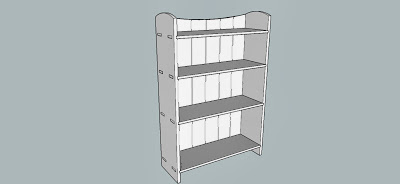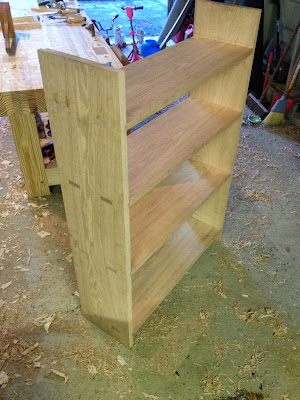Over the past few months or so I have been working on a small treasure box that will be a Christmas gift for my daughter. This project seemed like a perfect use for some of the spalted 6/4 curly maple I have stashed away. I haven't used any of this wood yet so I really wasn't sure what the inside of this board would look like after resawing it and planing it down.
I crosscut off a section that would yield the length needed for the box and it was cool to see that the lines and colors from the spalting went all the way through the board.
I then ripped this piece down the middle and set aside half for another project.
I re-sawed the remaining piece down the middle to create two bookmatched pieces. By flipping these pieces inside out I can then create a box continuous grain at all four corners.
Next I jointed and planed these pieces to get them flat and even in thickness. Then I setup a dado stack in the table saw and ran a 1/4" groove along the top and bottom edges to capture the panels that will make up the top of the lid as well as the bottom of the box. I also cut a wider groove located about 3/4 of the way up the side which will is where the lid will be split from the box later on. This groove will then get some small strips of wood glued on which will serve to register the lid onto the box.
Next I used a set of dividers to layout the proportions of of the front and sides and then mark out which pieces will become the front, sides, and back of the box.
The front, sides, and back of the box will be joined at the corners by a miter joint and reinforced with a vertical spline along the length of the miter. After setting up the table saw to cut a decent 45 degree angle (this took a few test cuts) I crosscut the pieces.
The time spent tweaking the angle of the table saw was well spent as the box came together with nice tight miters.
The next step was to setup the table saw to cut the grooves along the miters for the splines at each corner. I clamped a sacrificial scrap to the table saw fence and bumped it right up to the blade get the groove in the right spot.
Below you can see how the splines will sit across the miter and provide some long grain to long grain glue surface to make a nice strong joint.
I couldn't help taping the box together to get a feel for the proportions and the continuous grain around the corners.
At this point I shifted focus to the panel for the lid. I wanted to use a contrasting wood and was initially thinking a nice piece of walnut would look nice but I ended up finding a nice piece of cherry that was just the right size and had some nice cathedral grain.
I crosscut the piece from the larger board and then roughly flattened it by hand.
I then ran the board through the thickness planer to make both faces flat and parallel.
I then started working on cutting the features that would interlock with the groove around the top edge of the box. I started with a saw kerf that defines the thickness of the tab that fits into the groove.
Next I cut another saw kerf to fit over the top edge of the box and also removed all of the material in between.
I then trimmed back the lower tab to fit the dimensions of grooves with the box assembled. Below you can see the lid panel upside down. The longer tab will overlap the top of the box and will be trimmed back later.
Below you can see the lid in place with some mineral spirits applied to highlight the grain. Over time the cherry will darken even more enhancing the contrast against the lighter maple.
To close out the box I then started working on a panel for the bottom. I didn't have any thin stock wide enough to span the box with a single piece but I did have some thin oak stock that would work well once glued into a wider panel. I planed the stock down to a consistent thickness and then used a jointer plane to true up the edges for the glue joint.
It's now too cold outside for the glue to cure properly so I headed down to the basement with a few clamps.
I used the wooden hand screws to keep the thin pieces aligned and clamped them up with the parallel clamps.
After the glue cured I ran the panel through the planer to even up the glue joint and bring the panel to just the right thickness to fit the groove in the bottom of the box. I then trimmed the panel down to fit the dimensions of the box.
The pieces of oak that make up the bottom were both straight grained so the glue joint doesn't stand out much, good enough for a box bottom.
With the bottom complete I shifted focus to the lid, trimming back cherry panel to overlap the box edges a bit. To my eye this looks a bit nicer and also exposes the splines that reinforce the mitered corners.
Before assembling the box I used a side piece as a gauge to test the cherry strips that would eventually register the lid to the box as I planed them down to just the right thickness to fit into the groove.
At this point I pre-finished the lid, the bottom panel, and the inside surfaces of the sides. I typically use wipe-on poly for most projects but since the oil based poly tends to stink forever in an enclosed area, I decided to use shellac for this project.
After playing around with a few assembly dry runs I realized it wasn't going to be easy getting all the mitered corners to close up tightly. I decided to glue on some 45 degree blocks at each corner to allow clamps to be applied to apply pressure right across each miter. I applied a few drops of glue and simply rubbed the blocks onto the box sides.
Once the glue blocks were dry I moved forward with the assembly. It was a bit of a trick to get the bottom and top panels in place, apply glue to the miters and insert the splines, and then get all the clamps on as quickly as possible. As I was tightening up the clamps the last few turns two of the glue blocks popped off, teaching me a good lesson that they need to be glued on a bit more carefully next time. Unfortunately the missing glue blocks prevented me from pulling on of the miters completely closed leaving a small gap at the back right corner.
After letting the glue dry I took the box back out to the shop to trim off the glue blocks and splines at the corners.
The splines came off fairly easily with a sharp chisel.
I attacked the glue blocks on the bandsaw to remove most of the scrap.
I then planed off the last fraction of an inch with the block plane...
...and then followed that up with the smoothing plane to clean up the outside surfaces of the box one last time. Overall removing the glue blocks wasn't bad, I'll most likely use this technique again on miters like this but I'll make sure to glue them on a bit more carefully next time.
I then eased the corners of the box with the block plane, rounding them over slightly. I also added a small bevel on the cherry panel in the lid.
When it was finally time to separate the lid from the box I setup the table saw to cut just a hair short of the thickness of the side, taking into account the depth of the groove on the inside.
I sawed all four sides and then cut through the remaining paper thin connection with a knife to release the lid.
I then went back to the cherry strips I had cut and planed to thickness earlier, and mitered them to fit into the top of the box. These strips were then glued in forming a lip to register the lid.
At this point the box was mechanically complete and I moved on to the finishing process. I ended up wiping on multiple coats of shellac, sanding between coats. I wasn't able to get a perfectly smooth surface just wiping on the shellac so I ended up wet sanding the last coat with 400 grit wet/dry lubed with a bit of mineral spirits to even out a few imperfections. I finished that off with some paste wax applied with a green scotchbrite and buffed it out to a decent satin gloss.
Overall the shellac and wax combination left a nice smooth finish that is as nice to touch as it is to look at.
This box should be a nice container for a few small Christmas gifts and should also make a nice little treasure box after that.

























































































